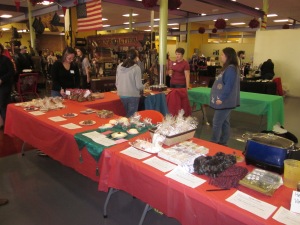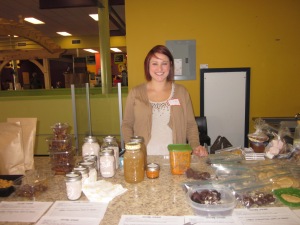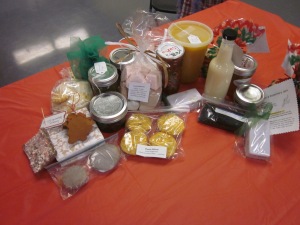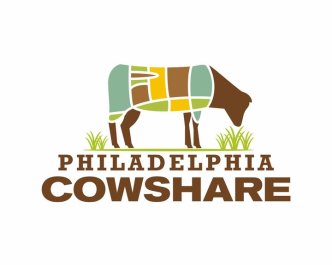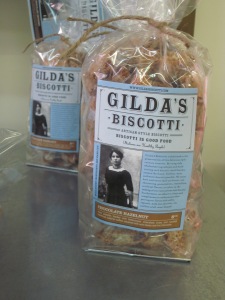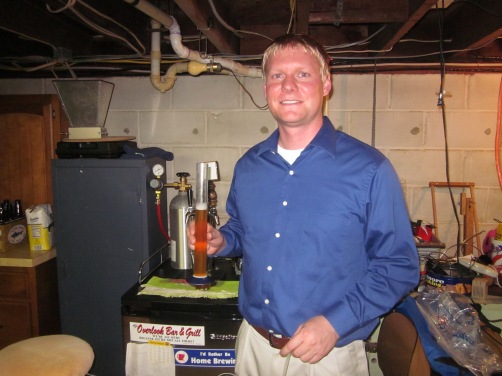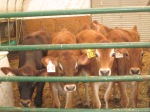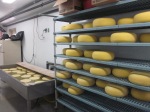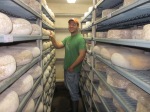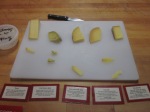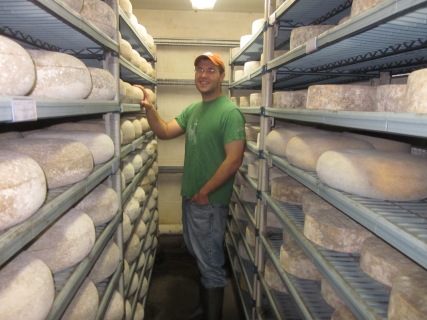
Head Cheesemaker Sam Kennedy notes the cheese’s varied rind textures on a stroll through “the caves,” where cheese is left to age.
Just as Sam Kennedy, head cheesemaker at Cherry Grove Farm in Lawrenceville, can take one ingredient and turn it into a variety of cheeses, my one visit to the farm could yield a plethora of posts. A lot can be learned from the farm’s business model: the cheesemaking is slow, the operation is small and the process of pasturing cattle on organic grass is as sustainable as any natural cycle.
Curious about what makes cheese naturally yellow? Or why Toma needs to be washed? I pulled Kennedy away from working on the farm’s famous Toma cheese for a quick Q&A on this strange intersection of art, science and culinary nuance.
Q: What is the backstory behind the farm?
A: The owners wanted a spot where the locals could buy quality locally and environmentally produced food…We first started off as an egg-producing farm, and we still produce free-range chicken eggs. And then we went into grass-fed beef, grass-fed lamb, and eventually went into grass-fed dairy and started backing off on the grass-fed beef, because grass-fed dairy is a much more economically efficient formula in New Jersey than grass-fed beef. It takes a very large land mass to do grass-fed beef very well, and in NJ it’s just too expensive.
Q: Can you explain a little bit about what it means to say that Cherry Grove Farm is organic?
A: Well, the grass is certified organic. What that means is 98% of our cows’ diets—and even 99% depending on the time of year—comes from our land. When the grass is certified organic and that’s the predominant diet of your cows, then it really stands out in the flavors of your cheeses. In the summertime you’ll get different flavor notes than what you’ll get in the winter time, and that’s just because of what the cow is eating. It also means our cheeses are going to be a little healthier for you. …. [Our cheeses] are automatically going to be higher in omega 3’s and higher in CLA from the grass-fed quality. The yellow that you see in our cheeses is the cow’s inability to use beta carotene, so you’re getting a large dose of beta carotene when you’re eating our cheeses.
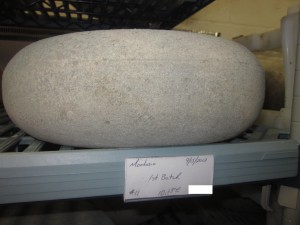
A wheel of Montasio aging in the caves. Kennedy asked that the pH measurement written in the lower right corner be blurred, as the pH of a given cheese is considered proprietary information in cheesemaking.
Q: How did you get involved in cheese-making?
A: I have a culinary arts background. Being a chef I was always interested in cheese. I started going toward the research and development side of culinary world, where you’re dealing with very large corporations making nationally known recipes … [but] a lot of the foods that are produced by those large companies are not ethically responsible. They don’t have their customers in their minds when they produce them; they just have a dollar bill in their minds. So cheesemaking’s the natural side of that. It’s the natural R&D work of the chef world.
Q: We just called you in from the cheese production area. What exactly was it that you were doing in there?
A: We’re producing jack today. We have 200 gallons in the vat. That’s what my assistant Malachy [Egan] was doing…Now he’s cutting and cooking the cheese. Today I’m doing more “affinage” work, which means “finishing cheese” in French, so you just pulled me out of washing the Tomas. I’m in there individually treating each wheel of cheese, gently washing it in a salt brine solution.
Q: There seem to be a lot of processes that take place during the aging of the cheese. What do they do? How does washing the Toma make it different from other cheeses?
It makes it more creamy and it grows that red mold that’s very specific to our farm. That’s what we’re trying to get with that cheese. What’s really interesting with those cheeses is the Herdsman and Toma are the same exact cheese when we create it in the vat, but they change in the affinage. The Toma gets washed and the herdsman just hangs out and gets that nice multi-layered rind so that’s what defines the two flavor profiles in that cheese…One of the cool and exciting things of the cheese world is that I can take one ingredient or one product and I can create many different things from using some different methods. I could create a different Toma by using a flavored liquid besides water: beer, wine, cider, any type of fruit juice, anything really. I could just put herbs and spices into my water solution and little bits of that would come out in the cheese to get that little bit of curiosity in the flavor profile.
Thanks to everyone at Cherry Grove Farm for the awesome tour, samples and information! Cherry Grove Farm’s cheeses can be found in specialty grocers all over New Jersey.
